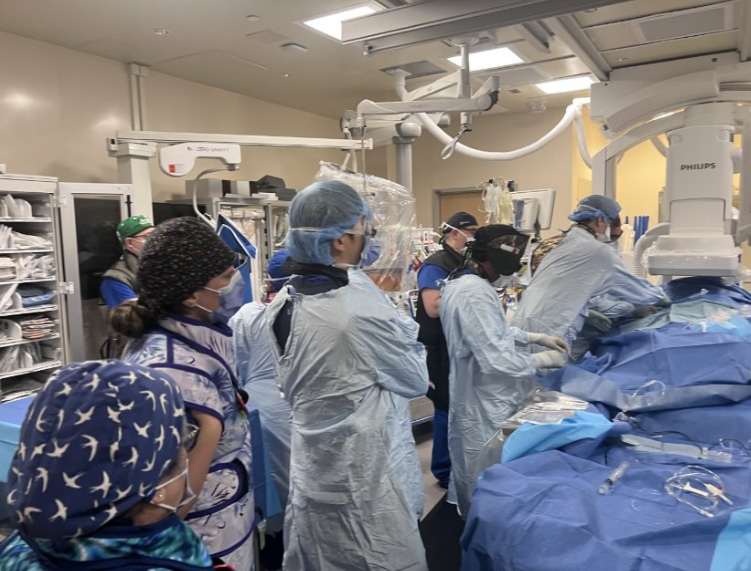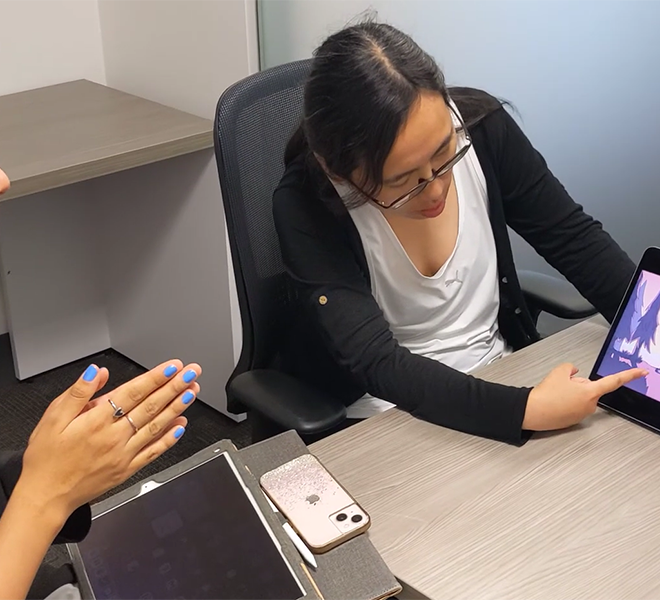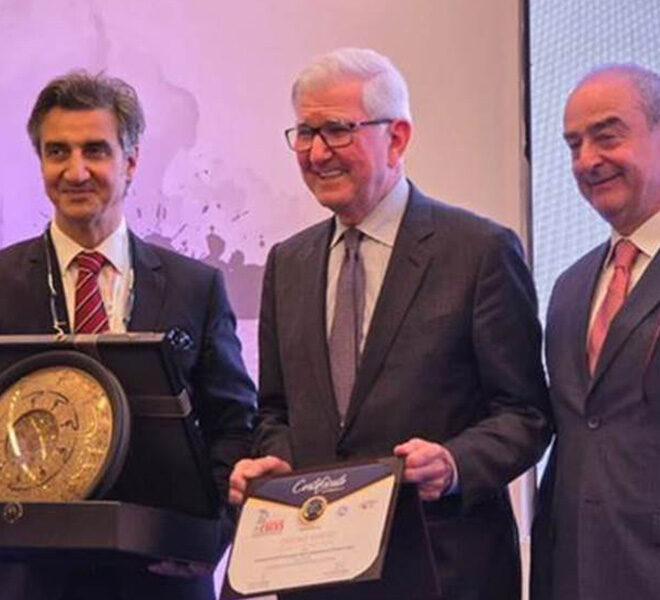
Dr. Krishnakumar Nair and Dr. Andrew Ha, electrophysiologists at UHN’s Peter Munk Cardiac Centre, used a vein in the liver to access the chambers of a patient’s heart. Access to the vein in the liver was obtained by the interventional radiology team led by Dr George Oreopoulos. This procedure, a Canadian-first on an adult patient, has been performed by only a handful of specialized centres in the world.
UHN
Peter Munk Cardiac Centre Team performs Canadian-first adult cardiac procedure
In a Canadian-first procedure, a surgical team at UHN’s Peter Munk Cardiac Centre (PMCC) has eliminated an adult patient’s irregular heartbeat – arrhythmia – by accessing the heart through a vein in the liver.
The procedure, known as a trans-hepatic approach, was performed earlier this spring on a patient with a congenital heart disease who had an interrupted inferior vena cava (IVC) – the vein responsible for transporting deoxygenated blood from the lower body to the right side of the heart, which is the typical point of entry to destroy atrial arrhythmias.
“This is a new way for us to perform arrhythmia ablation for a subset of patients with congenital heart disease,” says Dr. Krishnakumar Nair, cardiac electrophysiologist at PMCC.
The catheter-based procedure was performed on 60-year-old patient Amy Shannon, the first adult to receive the surgery in Canada.
“I knew Toronto General Hospital was the best place to have my surgery done,” says Amy, a retired teacher who was born with a heart defect called anomalous left coronary artery from the pulmonary artery (ALCAPA). It was discovered at age 48 after she began experiencing shortness of breath when walking and resting, a rare diagnosis as it’s most often noticed in babies and young children.
“When I go [to TGH], I know that I’m safe and that I can trust everyone from the nurses to the doctors, which makes me feel very secure,” she says.
ALCAPA occurs when the left coronary artery arises from the pulmonary artery, carrying blood without oxygen to the side of the heart. In Amy’s case, her right coronary artery had been supplying oxygen to the left side of her heart.
After having open heart surgery for her ALCAPA, she began experiencing arrhythmias.
Amy was prescribed medication for the arrhythmia but was drug-resistant. Instead, she needed an ablation – a procedure that burns heart cells to cause scarring on the inside of the heart, breaking up the electrical signals that cause irregular heartbeats and helping to maintain a normal heart rhythm.
Because Amy’s IVC did not drain directly to the heart, Dr. Nair, her primary cardiac electrophysiologist, thought of an alternative solution to get into Amy’s heart to perform the ablation: getting access to the left atrium via one of the veins in the liver, something only a handful of specialized centres in the world have done to date – making UHN the first in Canada to use the approach on an adult patient.
Dr. George Oreopoulos and the interventional radiology team created a small surgical passage for hepatic access, enabling the subsequent ablation of the left atrium by the electrophysiology team led by Dr Nair.
The surgery went smoothly, with no complications reported during or after the procedure. Notably, the patient experienced significant improvement in her arrhythmic symptoms at the one-month follow-up.
“TGH has the world’s largest adult congenital cardiac centre, and a significant proportion of patients with operative heart disease have arrhythmias,” says Dr. Nair.
Amy has recovered well since having the surgery and says that she no longer needs cardioversion – a procedure used to return an abnormal heartbeat to a normal rhythm, something that she would often endure prior to the treatment. She continues to travel from her home in Lindsay, Ont. to TGH’s Congenital Heart Clinic for checkups.
‘Multidisciplinary collaboration is the UHN ‘superpower”
The procedure was a department-wide collaboration between cardiac electrophysiology, congenital heart disease, anesthesiology, interventional radiology, catheterization laboratory and nursing.
“One of the strengths of UHN is that there are experts in multiple disciplines,” says Dr. Andrew Ha, cardiac electrophysiologist and Director of Electrophysiology at PMCC, who worked on Amy’s case alongside Dr. Nair.
“If you have a patient need like Amy, you can offer something that is creative, safe, cutting edge, and you can draw on the expertise of multiple people to do it.
“The advocacy to push boundaries of patient care at UHN allows us to find safe and innovative ways to help our patients, even if it’s never been done before.”
This achievement was the result of a multidisciplinary effort involving UHN nurses, educators, the catheterization team and several physicians, including: Dr. Nair, Dr. Ha and Dr. Jayant Kakarla (fellow) of the cardiac electrophysiology team; Dr. Oreopoulos and Dr. Omid Shearkhani (fellow) of the interventional radiology team; Dr. Marjan Jariani and Dr. Adam Snyman of the anesthesiology team; and Dr. Rafael Alonso-Gonzalez of the congenital heart disease team.
“Multidisciplinary collaboration is the UHN ‘superpower’ that allows teams to offer hope to patients with the most complex problems,” Dr. Oreopoulos says. “We teach our residents and fellows the benefits of this institutional culture so that they may be a force to bring others together to help their own patients in the future.”

